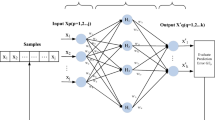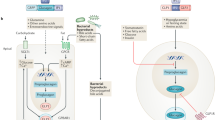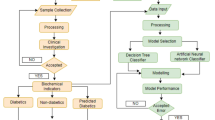Abstract
Among the most serious consequences of diabetes mellitus is the development of diabetic angiopathy, of which the clinical features are cardiovascular disease, retinopathy, nephropathy and neuropathy. Diabetic kidney problems affect up to one third of all patients with diabetes mellitus and are a major cause of end-stage renal failure. Although a huge number of pharmaceutical interventions are available today, diabetic angiopathy remains a leading cause of mortality and morbidity in diabetes mellitus, therefore, an urgent need exists to develop new therapeutic strategies. Recent data support the hypothesis that dysregulation of the complement system and of members of the tumor necrosis factor (TNF) superfamily may be involved in the development of diabetic vascular complications. The mannose-binding lectin pathway—an overall regulatory component of the complement system—is a particularly promising biomarker as it is directly involved in the development of diabetic angiopathy. In addition, two components of the TNF superfamily, namely TRAIL (tumor necrosis factor-related apoptosis-inducing ligand) and osteoprotegerin, may be involved in the pathogenesis of diabetic angiopathy. Several ways of specifically manipulating the complement and TNF superfamily systems already exist, but whether or not these drugs provide new targets for intervention for late diabetic complications is still to be revealed.
Key Points
-
The development of diabetic angiopathy has serious individual and societal consequences because of the substantial impact on morbidity and mortality
-
Despite lifestyle changes and drug intervention against hyperglycemia, hypertension and dyslipidemia, microvascular and macrovascular complications are still a clinical problem in patients with diabetes mellitus
-
An ongoing need exists to develop better risk markers of diabetic angiopathy and drugs that act more specifically
-
Emerging evidence supports a role of the complement system and of members of the tumor necrosis factor superfamily in the pathogenesis of diabetic vascular complications
-
Mannose-binding lectin and osteoprotegerin are strong and independent biomarkers of microvascular and macrovascular complications in diabetes mellitus
-
Agonists and antagonists against components of the complement system and the tumor necrosis factor superfamily may prove effective in the treatment of diabetic vascular complications
This is a preview of subscription content, access via your institution
Access options
Subscribe to this journal
Receive 12 print issues and online access
$189.00 per year
only $15.75 per issue
Buy this article
- Purchase on SpringerLink
- Instant access to full article PDF
Prices may be subject to local taxes which are calculated during checkout




Similar content being viewed by others
References
International Diabetes Federation (IDF). Diabetes Atlas, 4th Edn. http://www.diabetesatlas.org/map (2009).
Rydén, L. et al. Guidelines on diabetes, pre-diabetes, and cardiovascular diseases: executive summary. The Task Force on Diabetes and Cardiovascular Diseases of the European Society of Cardiology (ESC) and of the European Association for the Study of Diabetes (EASD). Eur. Heart J. 28, 88–136 (2007).
US Renal Data System. USRDS 2008 Annual Data Report: Atlas of Chronic Kidney Disease and End-Stage Renal Disease in the United States (National Institutes of Health, National Institute of Diabetes and Digestive and Kidney Diseases, Bethesda, MD, USA, 2008).
Van Dijk, P. C. et al. Renal replacement therapy for diabetic end-stage renal disease: data from 10 registries in Europe (1991–2000). Kidney Int. 67, 1489–1499 (2005).
Stewart, J. H. et al. Trends in incidence of treated end-stage renal disease, overall and by primary renal disease, in persons aged 20–64 years in Europe, Canada and the Asia-Pacific region, 1998–2002. Nephrology 12, 520–527 (2007).
Pfützner, A. & Forst, T. High-sensitivity C-reactive protein as cardiovascular risk marker in patients with diabetes mellitus. Diabetes Technol. Ther. 8, 28–36 (2006).
Schalkwijk, C. G. et al. Plasma concentration of C-reactive protein is increased in type I diabetic patients without clinical macroangiopathy and correlates with markers of endothelial dysfunction: evidence for chronic inflammation. Diabetologia 42, 351–357 (1999).
Turner, M. W. The role of mannose-binding lectin in health and disease. Mol. Immunol. 40, 423–429 (2003).
Thiel, S. et al. A second serine protease associated with mannan-binding lectin that activates complement. Nature 386, 506–510 (1997).
Law, S. K. A. & Reid, K. B. M. Complement, 2nd Edn (IRL Press at Oxford University Press, Oxford, 1995).
Bianco, C., Griffin, F. M. Jr & Silverstein, S. C. Studies of the macrophage complement receptor. Alteration of receptor function upon macrophage activation. J. Exp. Med. 141, 1278–1290 (1975).
Griffin, F. M. Jr, Bianco, C. & Silverstein, S. C. Characterization of the macrophage receptor for complement and demonstration of its functional independence from the receptor for the Fc portion of immunoglobulin G. J. Exp. Med. 141, 1269–1277 (1975).
Østergaard, J. et al. Mannose-binding lectin deficiency attenuates renal changes in a streptozotocin-induced model of type 1 diabetes in mice. Diabetologia 50, 1541–1549 (2007).
Busche, M. N., Walsh, M. C., McMullen, M. E., Guikema, B. J. & Stahl, G. L. Mannose-binding lectin plays a critical role in myocardial ischaemia and reperfusion injury in a mouse model of diabetes. Diabetologia 51, 1544–1551 (2008).
Hansen, T. K. et al. Association between mannose-binding lectin and vascular complications in type 1 diabetes. Diabetes 53, 1570–1576 (2004).
Hansen, T. K. et al. Elevated levels of mannan-binding lectin in patients with type 1 diabetes. J. Clin. Endocrinol. Metab. 88, 4857–4861 (2003).
Saraheimo, M. et al. Increased levels of mannan-binding lectin in type 1 diabetic patients with incipient and overt nephropathy. Diabetologia 48, 198–202 (2005).
Hansen, T. K. et al. Mannose-binding lectin genotype and serum concentrations predict mortality in type 1 diabetes. Presented at the 66th Scientific session of the American Diabetes Organisation Washington, USA (2006).
Hovind, P. et al. Mannose-binding lectin as a predictor of microalbuminuria in type 1 diabetes: an inception cohort study. Diabetes 54, 1523–1527 (2005).
Berger, S. P. et al. Low pretransplantation mannose-binding lectin levels predict superior patient and graft survival after simultaneous pancreas-kidney transplantation. J. Am. Soc. Nephrol. 18, 2416–2422 (2007).
Hansen, T. K. et al. Mannose-binding lectin and mortality in type 2 diabetes. Arch. Intern. Med. 166, 2007–2013 (2006).
Wehner, H., Höhn, D., Faix-Schade, U., Huber, H. & Walzer, P. Glomerular changes in mice with spontaneous hereditary diabetes. Lab. Invest. 27, 331–340 (1972).
Mauer, S. M. et al. Pancreatic islet transplantation. Effects on the glomerular lesions of experimental diabetes in the rat. Diabetes 23, 748–753 (1974).
Mauer, S. M. et al. Studies of the rate of regression of the glomerular lesions in diabetic rats treated with pancreatic islet transplantation. Diabetes 24, 280–285 (1975).
Lee, C. S. et al. Renal transplantation in diabetes mellitus in rats. J. Exp. Med. 139, 793–800 (1974).
Fujita, T. et al. Complement activation accelerates glomerular injury in diabetic rats. Nephron 81, 208–214 (1999).
Chiarelli, F., Verrotti, A., La Penna, G. & Morgese, G. Low serum C4 concentrations in type-1 diabetes mellitus. Eur. J. Pediatr. 147, 197–198 (1988).
Barnett, A. H. et al. Low plasma C4 concentrations: association with microangiopathy in insulin dependent diabetes. Br. Med. J. (Clin. Res. Ed.) 289, 943–945 (1984).
Falk, R. J. et al. Ultrastructural localization of the membrane attack complex of complement in human renal tissues. Am. J. Kidney Dis. 9, 121–128 (1987).
Haahr-Pedersen, S. et al. Level of complement activity predicts cardiac dysfunction after acute myocardial infarction treated with primary percutaneous coronary intervention. J. Invasive Cardiol. 21, 13–19 (2009).
Qin, X. et al. Glycation inactivation of the complement regulatory protein CD59: a possible role in the pathogenesis of the vascular complications of human diabetes. Diabetes 53, 2653–2661 (2004).
Zauli, G. & Secchiero, P. The role of the TRAIL/TRAIL receptors system in hematopoiesis and endothelial cell biology. Cytokine Growth Factor Rev. 17, 245–257 (2006).
Lorz, C., Benito, A., Ucero, A. C., Santamaría, B. & Ortiz, A. TRAIL and kidney disease. Front. Biosci. 14, 3740–3749 (2009).
Yasuda, H. et al. Osteoclast differentiation factor is a ligand for osteoprotegerin/osteoclastogenesis-inhibitory factor and is identical to TRANCE/RANKL. Proc. Natl Acad. Sci. USA 95, 3597–3602 (1998).
Emery, J. G. et al. Osteoprotegerin is a receptor for the cytotoxic ligand TRAIL. J. Biol. Chem. 273, 14363–14367 (1998).
Lorz, C. et al. The death ligand TRAIL in diabetic nephropathy. J. Am. Soc. Nephrol. 19, 904–914 (2008).
Sanchez-Niño, M. D. et al. The MIF receptor CD74 in diabetic podocyte injury. J. Am. Soc. Nephrol. 20, 353–362 (2009).
Benito-Martín, A. et al. Transcriptomics illustrate a deadly TRAIL to diabetic nephropathy [Spanish]. Nefrologia 29, 13–19 (2009).
Mi, Q. S. et al. Blockade of tumor necrosis factor-related apoptosis-inducing ligand exacerbates type 1 diabetes in NOD mice. Diabetes 52, 1967–1975 (2003).
Lamhamedi-Cherradi, S. E., Zheng, S., Tisch, R. M. & Chen, Y. H. Critical roles of tumor necrosis factor-related apoptosis-inducing ligand in type 1 diabetes. Diabetes 52, 2274–2278 (2003).
Secchiero, P. et al. Systemic tumor necrosis factor-related apoptosis-inducing ligand delivery shows antiatherosclerotic activity in apolipoprotein E-null diabetic mice. Circulation 114, 1522–1530 (2006).
Michowitz, Y. et al. The involvement of tumor necrosis factor-related apoptosis-inducing ligand (TRAIL) in atherosclerosis. J. Am. Coll. Cardiol. 45, 1018–1024 (2005).
Schoppet, M., Sattler, A. M., Schaefer, J. R. & Hofbauer, L. C. Osteoprotegerin (OPG) and tumor necrosis factor-related apoptosis-inducing ligand (TRAIL) levels in atherosclerosis. Atherosclerosis 184, 446–447 (2006).
Secchiero, P. et al. Potential prognostic significance of decreased serum levels of TRAIL after acute myocardial infarction. PLoS One 4, e4442 (2009).
Niessner, A. et al. Prognostic value of apoptosis markers in advanced heart failure patients. Eur. Heart J. 30, 789–796 (2009).
Tyson, K. L. et al. Osteo/chondrocytic transcription factors and their target genes exhibit distinct patterns of expression in human arterial calcification. Arterioscler. Thromb. Vasc. Biol. 23, 489–494 (2003).
Schoppet, M. et al. Localization of osteoprotegerin, tumor necrosis factor-related apoptosis-inducing ligand, and receptor activator of nuclear factor-kappaB ligand in Mönckeberg's sclerosis and atherosclerosis. J. Clin. Endocrinol. Metab. 89, 4104–4112 (2004).
Olesen, P., Ledet, T. & Rasmussen, L. M. Arterial osteoprotegerin: increased amounts in diabetes and modifiable synthesis from vascular smooth muscle cells by insulin and TNF-alpha. Diabetologia 48, 561–568 (2005).
Olesen, P., Nguyen, K., Wogensen, L., Ledet, T. & Rasmussen, L. M. Calcification of human vascular smooth muscle cells: associations with osteoprotegerin expression and acceleration by high-dose insulin. Am. J. Physiol. Heart Circ. Physiol. 292, H1058–H1064 (2007).
Hofbauer, L. C. & Schoppet, M. Osteoprotegerin gene polymorphism and the risk of osteoporosis and vascular disease. J. Clin. Endocrinol. Metab. 87, 4078–4079 (2002).
Clancy, P., Oliver, L., Jayalath, R., Buttner, P. & Golledge, J. Assessment of a serum assay for quantification of abdominal aortic calcification. Arterioscler. Thromb. Vasc. Biol. 26, 2574–2576 (2006).
Abedin, M. et al. Relation of osteoprotegerin to coronary calcium and aortic plaque (from the Dallas Heart Study). Am. J. Cardiol. 99, 513–518 (2007).
Scatena, M. & Giachelli, C. The αvβ3 integrin, NF-κB, osteoprotegerin endothelial cell survival pathway. Potential role in angiogenesis. Trends Cardiovasc. Med. 12, 83–88 (2002).
Bucay, N. et al. Osteoprotegerin-deficient mice develop early onset osteoporosis and arterial calcification. Genes Dev. 12, 1260–1268 (1998).
Heinonen, S. E. et al. Increased atherosclerotic lesion calcification in a novel mouse model combining insulin resistance, hyperglycemia and hypercholesterolemia. Circ. Res. 101, 1058–1067 (2007).
Vaccarezza, M., Bortul, R., Fadda, R. & Zweyer, M. Increased OPG expression and impaired OPG/TRAIL ratio in the aorta of diabetic rats. Med. Chem. 4, 387–391 (2007).
Takemoto, M. et al. Enhanced expression of osteopontin in human diabetic artery and analysis of its functional role in accelerated atherogenesis. Arterioscler. Thromb. Vasc. Biol. 20, 624–628 (2000).
Rasmussen, L. M. & Ledet, T. Aortic collagen alterations in human diabetes mellitus. Changes in basement membrane collagen content and in the susceptibility of total collagen to cyanogen bromide solubilisation. Diabetologia 36, 445–453 (1993).
Heickendorff, L., Ledet, T. & Rasmussen, L. M. Glycosaminoglycans in the human aorta in diabetes mellitus: a study of tunica media from areas with and without atherosclerotic plaque. Diabetologia 37, 286–292 (1994).
Niskanen, L., Siitonen, O., Suhonen, M. & Uusitupa, M. I. Medial artery calcification predicts cardiovascular mortality in patients with NIDDM. Diabetes Care 17, 1252–1256 (1994).
Lehto, S., Niskanen, L., Suhonen, M., Rönnemaa, T. & Laakso, M. Medial artery calcification. A neglected harbinger of cardiovascular complications in non-insulin-dependent diabetes mellitus. Arterioscler. Thromb. Vasc. Biol. 16, 978–983 (1996).
Browner, W. S., Lui, L. Y. & Cummings, S. R. Associations of serum osteoprotegerin levels with diabetes, stroke, bone density, fractures, and mortality in elderly women. J. Clin. Endocrinol. Metab. 86, 631–637 (2001).
Galluzzi, F. et al. Osteoprotegerin serum levels in children with type 1 diabetes: a potential modulating role in bone status. Eur. J. Endocrinol. 153, 879–885 (2005).
Xiang, G. D., Sun, H. L. & Zhao, L. S. Changes of osteoprotegerin before and after insulin therapy in type 1 diabetic patients. Diabetes Res. Clin. Pract. 76, 199–206 (2007).
Rasmussen, L. M., Tarnow, L., Hansen, T. K., Parving, H. H. & Flyvbjerg, A. Plasma osteoprotegerin levels are associated with glycaemic status, systolic blood pressure, kidney function and cardiovascular morbidity in type 1 diabetic patients. Eur. J. Endocrinol. 154, 75–81 (2006).
Knudsen, S. T. et al. Increased plasma concentrations of osteoprotegerin in type 2 diabetic patients with microvascular complications. Eur. J. Endocrinol. 149, 39–42 (2003).
Xiang, G. D., Xu, L., Zhao, L. S., Yue, L. & Hou, J. The relationship between plasma osteoprotegerin and endothelium-dependent arterial dilation in type 2 diabetes. Diabetes 55, 2126–2131 (2006).
Avignon, A. et al. Osteoprotegerin is associated with silent coronary artery disease in high-risk asymptomatic type 2 diabetic patients. Diabetes Care 28, 2176–2180 (2005).
Avignon, A. et al. Osteoprotegerin: a novel independent marker for silent myocardial ischemia in asymptomatic diabetic patients. Diabetes Care 30, 2934–2939 (2007).
Mikami, S. et al. Serum osteoprotegerin as a screening tool for coronary artery calcification score in diabetic pre-dialysis patients. Hypertens. Res. 31, 1163–1170 (2008).
Shin, J. Y., Shin, Y. G. & Chung, C. E. Elevated serum osteoprotegerin levels are associated with vascular endothelial dysfunction in type 2 diabetes. Diabetes Care 29, 1664–1666 (2006).
Jorsal, A. et al. Plasma osteoprotegerin levels predict cardiovascular and all-cause mortality and deterioration of kidney function in type 1 diabetic patients with nephropathy. Diabetologia 51, 2100–2107 (2008).
Anand, D. V., Lahiri, A., Lim, E., Hopkins, D. & Corder, R. The relationship between plasma osteoprotegerin levels and coronary artery calcification in uncomplicated type 2 diabetic subjects. J. Am. Coll. Cardiol. 47, 1850–1857 (2006).
Hjelmesaeth, J. et al. Early posttransplant serum osteoprotegerin levels predict long-term (8-year) patient survival and cardiovascular death in renal transplant patients. J. Am. Soc. Nephrol. 17, 1746–1754 (2006).
Nellemann, B. et al. Simvastatin reduces plasma osteoprotegerin in type 2 diabetic patients with microalbuminuria. Diabetes Care 30, 3122–3124 (2007).
Sultan, A. et al. Osteoprotegerin, thiazolidinediones treatment, and silent myocardial ischemia in type 2 diabetic patients. Diabetes Care 31, 593–595 (2008).
Rasmussen, L. M. & Ledet, T. Osteoprotegerin and diabetic macroangiopathy. Horm. Metab. Res. 37 (Suppl. 1), 90–94 (2005).
Author information
Authors and Affiliations
Ethics declarations
Competing interests
The author declares no competing financial interests.
Rights and permissions
About this article
Cite this article
Flyvbjerg, A. Diabetic angiopathy, the complement system and the tumor necrosis factor superfamily. Nat Rev Endocrinol 6, 94–101 (2010). https://doi.org/10.1038/nrendo.2009.266
Issue date:
DOI: https://doi.org/10.1038/nrendo.2009.266
This article is cited by
-
Multiplatform tear proteomic profiling reveals novel non-invasive biomarkers for diabetic retinopathy
Eye (2024)
-
Mannose-binding lectin does not explain the dismal prognosis after an acute coronary event in dysglycaemic patients. A report from the GAMI cohort
Cardiovascular Diabetology (2022)
-
Plasma glycated CD59 (gCD59), a novel biomarker for the diagnosis, management and follow up of women with Gestational Diabetes (GDM) – protocol for prospective cohort study
BMC Pregnancy and Childbirth (2020)
-
Molecular pathophysiology of diabetes mellitus during pregnancy with antenatal complications
Scientific Reports (2020)
-
Tumor necrosis factor alpha in peripheral neuropathy in type 2 diabetes mellitus
The Egyptian Journal of Neurology, Psychiatry and Neurosurgery (2019)



